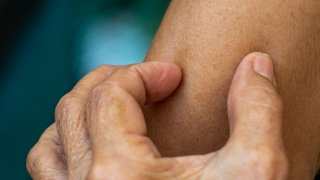
Several beaches in a Connecticut town have been connected to cases of swimmer's itch, a skin rash that forms from microscopic parasites, according to health officials.
The Greenwich Department of Health said Monday they were informed of multiple occurrences of the skin rash, also called cercarial dermatitis. It was not immediately clear when the cases were found.
It's not known how long the water may be impacted by the tiny parasites that are released from snails into fresh or salt water, as multiple factors must be present in order for it to become a problem. However, these factors may constantly be changing and can't be tested for.
The department said they requested all town beaches post messages alerting residents to possible risk, as a precaution. If the problem intensifies at any location, the Health Department would have to consider closing down that beach.
Get Tri-state area news and weather forecasts to your inbox. Sign up for NBC New York newsletters.
What is swimmer's itch?
Swimmer's itch appears as a skin rash caused by an allergic reaction to tiny, microscopic parasites, according to the Greenwich Health Department. Those parasites can be found in fresh water or salt water, including lakes, ponds and oceans.
Generally, the parasites don't tend to be attracted to humans, but can cause a rash if they come in contact with a person. Swimmer's itch is not contagious and can't spread from one person to another, according to Greenwich health officials.
News
Cases of swimmer's itch pop up around the world, mostly during summer months, the health officials said. Not everyone who swims in water with the parasites will be infected, but the longer a swimmer is in contact with them, the higher the chances of catching swimmer's itch.
Symptoms of swimmer's itch
Those who have contracted swimmer's itch may start to show symptoms within a short period of time, with small reddish pimples appearing about 12 hours after exposure, the health department said. Small blisters may also show up where those pimples occurred.
Health officials also said that tingling, burning or itching of the skin could occur as soon as minutes after exposure, or could take a few days.
Swimmer's itch prevention and treatment
In order to prevent a possible case, towel off and shower immediately after getting out of the water, thoroughly rinsing all areas, includes under the bathing suit.
Children are more susceptible, as they will go in recreational swimming areas for hours and are less likely to dry themselves off after coming out of the water.
While the rash will be itchy, scratching it will only lead to infection, according to health officials. The itchy feeling will go away in a short period, though any of the following can be used to help soothe the feeling:
- Corticosteroid cream
- Anti-itch lotion
- Bathing in Epsom salts or baking soda
- Soaking in colloidal oatmeal baths
- Applying baking soda paste to rash
- Using a cool compress on affected area
Most cases of swimmer's itch don't require medical attention, but if an infection does develop, contact a health care provider immediately.



